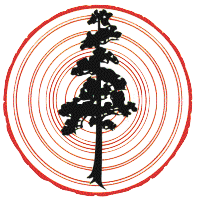Trimming and Planing Rough-Cut Wood For Efficient Dendrochronological Sample Preparation and Storage
Wood samples larger than increment cores collected for tree-ring studies are often obtained using chainsaws and, less frequently, 2-person crosscut saws. Saw marks on cross-sectional wood samples can be quite deep and uneven, and sanding rough-cut wood cross-sections is inefficient in terms of processing time and wear on sanding belts. Trimming rough-cut wood samples with a band saw or treating with a surface planer creates a smoother initial surface for sample sanding and polishing. Sample trimming with a band saw or surface planer is also useful for post-analysis archiving and wood storage, when excess wood can be removed and smaller samples entered into storage. Band saw and surface planer safety techniques are also discussed.ABSTRACT

Trimming rough-cut surface and unsound wood from a mounted cross-section. Adjustable blade guards on high-quality band saws promote user safety, as do personal protective equipment (ear and eye protection and a dustmask) and proper technique, such as “push sticks.”

(A) Pinus leiophylla sample surface showing very shallow kerf marks (equivalent to 40 grit sandpaper) following band-saw trimming. (B) Mismatched cuts create surfaces that are very difficult to sand without prior trimming.

Pegboard or a rubber mat can be used to hold samples securely for planing or sanding. Short dowels or a square jig are used to immobilize the sample.
Contributor Notes
